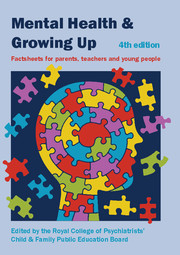Book contents
- Frontmatter
- Contents
- Contributors
- Factsheets for young people
- Factsheets for parents, carers and anyone who works with young people
- 1 Good parenting
- 2 The restless and excitable child
- 3 Dealing with tantrums
- 4 Children who soil or wet themselves
- 5 Sleep problems in childhood and adolescence
- 6 Behavioural problems and conduct disorder
- 7 Attention-deficit hyperactivity disorder (ADHD)
- 8 The child with general learning disability
- 9 Specific learning difficulties
- 10 Autism and Asperger syndrome
- 11 Depression in children
- 12 Worries and anxieties: helping children to cope
- 13 Divorce or separation of parents: the impact on children and adolescents
- 14 Death in the family: helping children to cope
- 15 The emotional cost of bullying
- 16 Traumatic stress in children
- 17 Domestic violence: its effects on children
- 18 Child abuse and neglect: the emotional effect
- 19 Drugs and alcohol: what parents need to know
- 20 Self-harm in young people
- 21 Psychosis
- 22 Schizophrenia
- 23 Bipolar disorder in children and adolescents
- 24 Obsessive–compulsive disorder in children and young people
- 25 Eating disorders in young people
- 26 Chronic physical illness: the effects on mental health
- 27 Medically unexplained physical symptoms
- 28 Chronic fatigue syndrome: helping your child get better
- 29 Parental mental illness: the problems for children
- 30 Who's who in CAMHS
23 - Bipolar disorder in children and adolescents
from Factsheets for parents, carers and anyone who works with young people
Published online by Cambridge University Press: 02 January 2018
- Frontmatter
- Contents
- Contributors
- Factsheets for young people
- Factsheets for parents, carers and anyone who works with young people
- 1 Good parenting
- 2 The restless and excitable child
- 3 Dealing with tantrums
- 4 Children who soil or wet themselves
- 5 Sleep problems in childhood and adolescence
- 6 Behavioural problems and conduct disorder
- 7 Attention-deficit hyperactivity disorder (ADHD)
- 8 The child with general learning disability
- 9 Specific learning difficulties
- 10 Autism and Asperger syndrome
- 11 Depression in children
- 12 Worries and anxieties: helping children to cope
- 13 Divorce or separation of parents: the impact on children and adolescents
- 14 Death in the family: helping children to cope
- 15 The emotional cost of bullying
- 16 Traumatic stress in children
- 17 Domestic violence: its effects on children
- 18 Child abuse and neglect: the emotional effect
- 19 Drugs and alcohol: what parents need to know
- 20 Self-harm in young people
- 21 Psychosis
- 22 Schizophrenia
- 23 Bipolar disorder in children and adolescents
- 24 Obsessive–compulsive disorder in children and young people
- 25 Eating disorders in young people
- 26 Chronic physical illness: the effects on mental health
- 27 Medically unexplained physical symptoms
- 28 Chronic fatigue syndrome: helping your child get better
- 29 Parental mental illness: the problems for children
- 30 Who's who in CAMHS
Summary
How common is bipolar disorder?
Bipolar disorder is extremely rare before puberty but becomes slightly more common during teenage years. It occurs in 1 in 100 or fewer children and teenagers. In adults it affects 1 in 100 people.
The condition can be hard to recognise in teenagers because more extreme behaviour can be part of this stage of life.
What causes it?
Although the causes are not fully understood, bipolar disorder tends to run in families. In people who have bipolar disorder, episodes may be triggered by physical illness, stressful events or lack of sleep.
What are the symptoms?
In bipolar disorder, a person can have:
• manic or hypomanic periods (or ‘episodes’) also known as ‘highs’
• depressive periods also known as ‘lows’
• mixed periods.
Below is a list of the symptoms in each episode. A young person needs to have at least one manic or hypomanic episode to be diagnosed with bipolar disorder. There needs to be several of these symptoms happening at the same time for at least several days. If there is just one symptom, then it is unlikely to be bipolar disorder.
The mood changes can sometimes occur very rapidly within hours or days (‘rapid cycling’). For some, the mood symptoms are less severe (‘cyclothymia’).
In between the highs and lows, there are ‘normal’ periods that can last for weeks or months. However, for some, especially when they have had the disorder from some time, these periods of ‘normalcy’ can be shorter or difficult to see.
Symptoms during a ‘high’ or manic episode
• Feeling incredibly happy or ‘high’ in mood, uncontrolled excitement
• Irritability
• Increased talkativeness
• Very rapid speech with lots of changes of subject
• Racing thoughts
• Increased activity and restlessness
• Difficulty in concentrating or being easily distracted, constant changes in plans
• Overconfidence and inflated ideas about themselves or their abilities
• Needing little sleep
• Neglect of personal care
• Increased sociability or overfamiliarity
• Increased sexual energy
• Overspending of money or other types of reckless or extreme behaviour.
- Type
- Chapter
- Information
- Mental Health and Growing UpFactsheets for Parents, Teachers and Young People, pp. 114 - 117Publisher: Royal College of PsychiatristsPrint publication year: 2013



